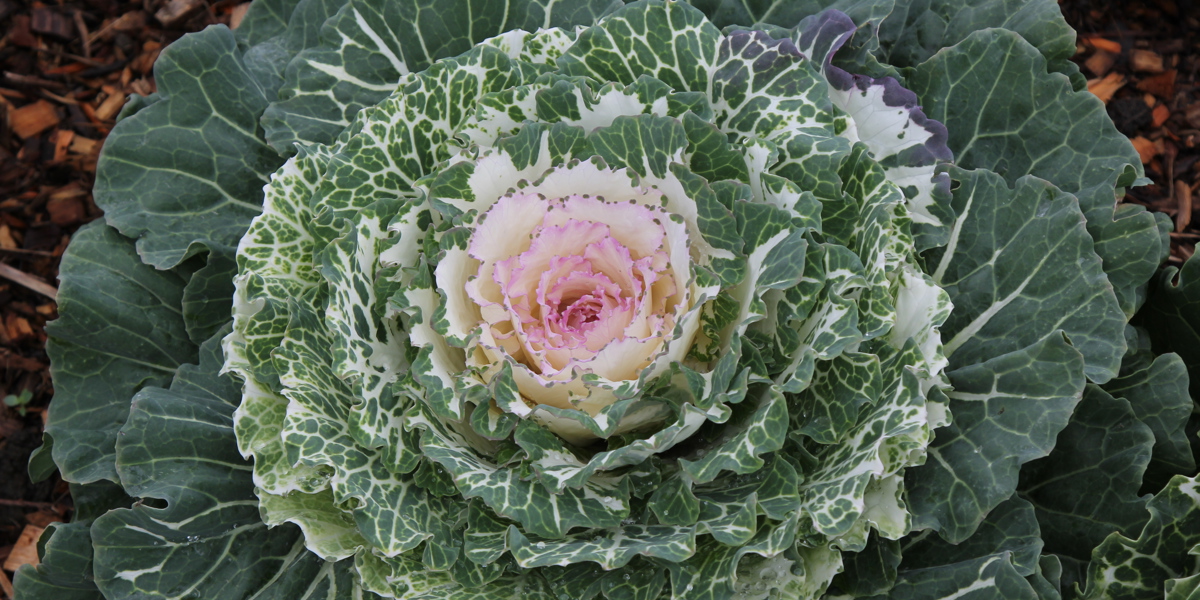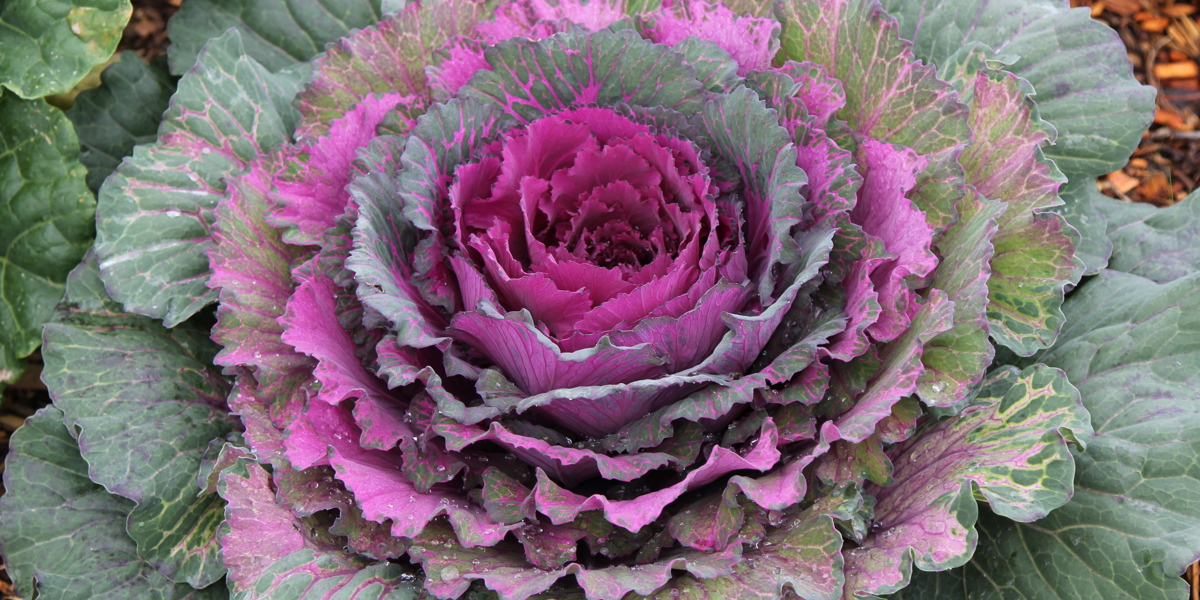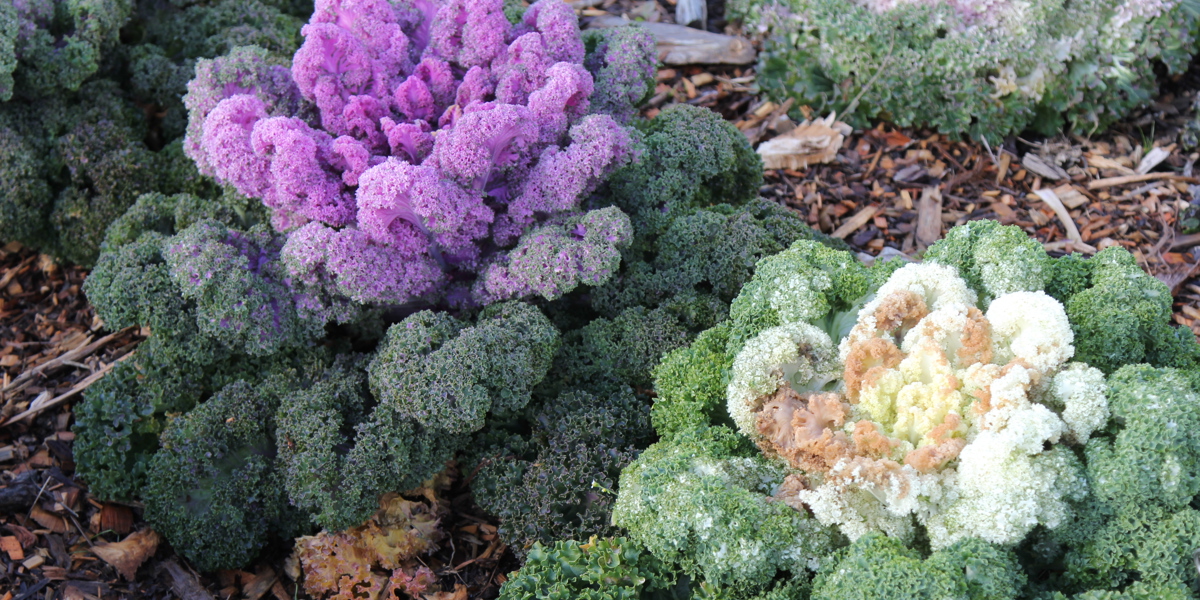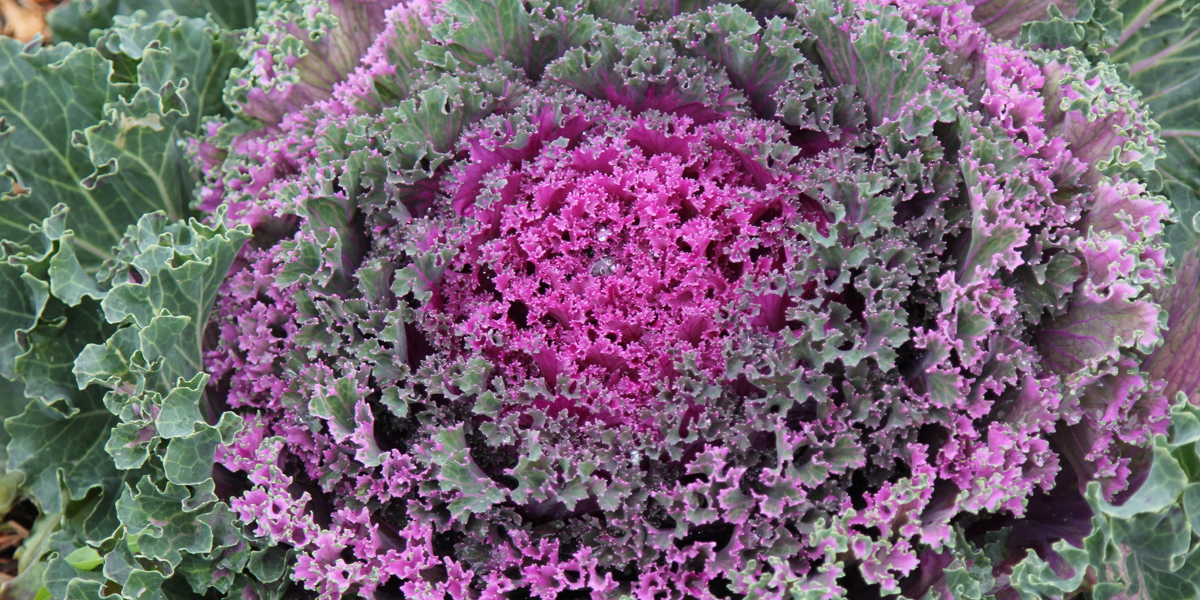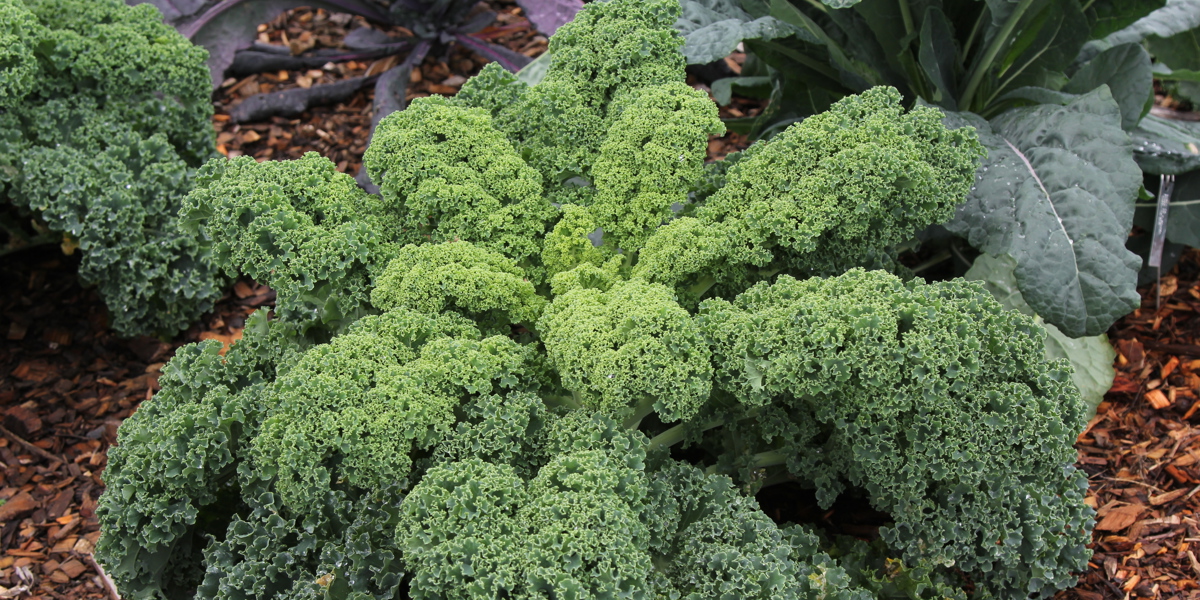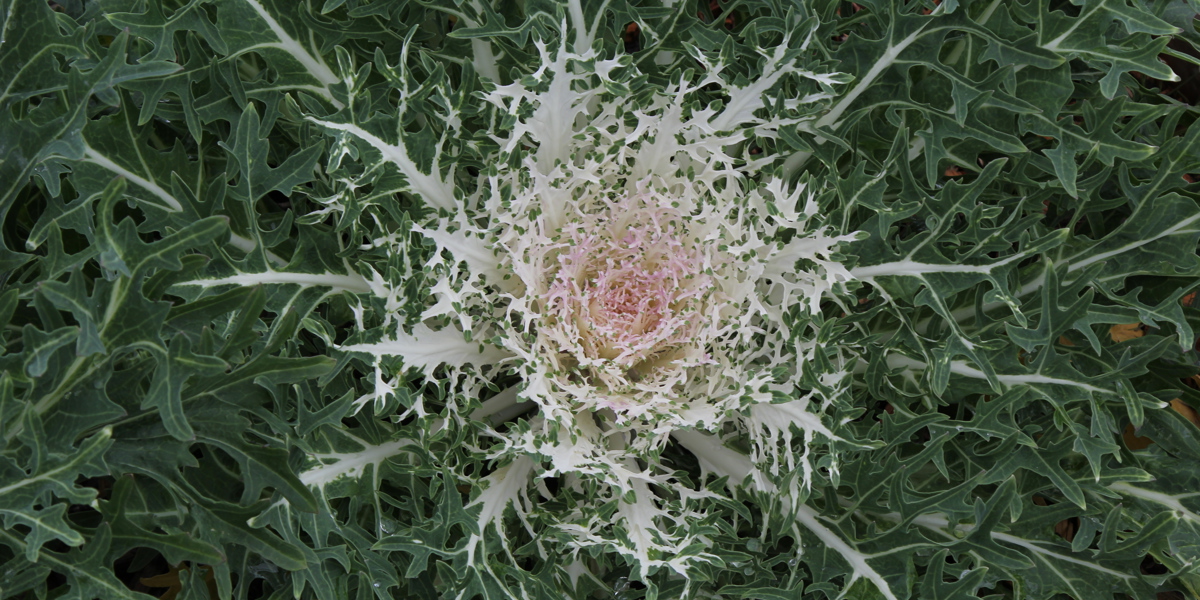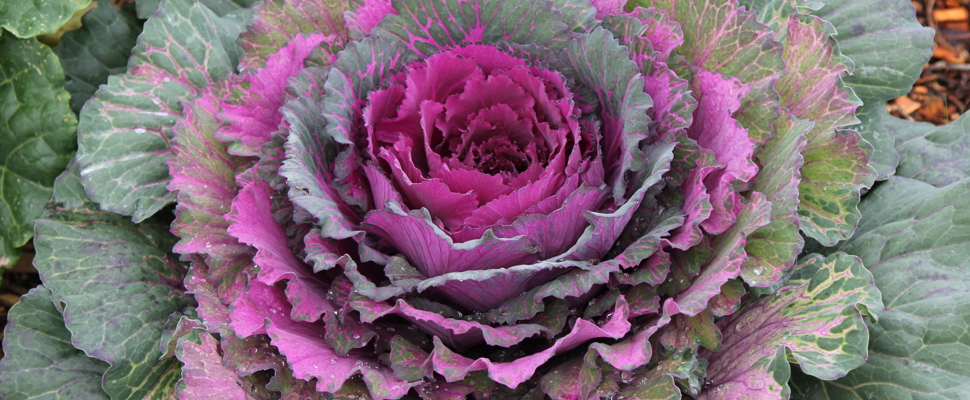
Kale for Auckland
Winter bedding trial 2021
Introduction
Kale (Brassica oleracea Acephala group), a member of the Brassicaceae family, is a fast-growing edible crop that produces curly greens over a long period. Although it is best known as a nutritious plant, ornamental strains have been developed with attractive foliage for use in annual bedding to provide texture and contrast. The relatively large size of kale means fewer plants are required in a planting space compared to many other annual bedding options.
At Auckland Botanic Gardens (ABG) we plant annual beds twice a year, in autumn and late spring/early summer. This is unlike many other public gardens which plant annual beds three times a year. We therefore require high performing annuals that have long flowering periods. Before planting annuals in our display gardens we trial them to ascertain their performance in mass plantings that are highly visible by the public.
The criteria we established to identify high performing kale for winter bedding was that they must provide effective ground cover, not flower and set seed before five months from planting, have 100% survival rate, be low maintenance and pest and disease resistant. The reason for including a long period before flowering is that ornamental kale are most attractive when in the vegetative phase.
Methods
Seeds of 13 cultivars of kale were sourced from Egmont Seeds, Egmont Seeds Professional and Kings Seeds. They were sown in the nursery and planted into the trial garden at the end of March 2021. Five or eight seedlings of each cultivar were planted. Depending on the size of each cultivar at maturity they were planted at either 45, 50 or 70 cm spacing based on the recommendations written on the seed packet. Plants were not watered throughout the duration of the trial.
Monthly observations of pests and diseases were made. The first date of flowering was recorded. At maturity, the average height and width of plants was measured before flowering and the foliage colours recorded using the Royal Horticultural Society (RHS) colour charts. An evaluation of overall performance was undertaken utilising the ABG star performer criteria (1 = poor performer to 10 = excellent performer). Cultivars that scored 8 or more are considered top performers and are recommended for Auckland conditions. The overall rating took into consideration flowering period, absence of pests and diseases, habit and vigour.
Some data collection was disrupted by the closure of the gardens in response to SARS coronavirus 2 (COVID-19) during August to October 2021.
Plants were removed at the end of the trial at the end of October 2021.
Results
From this trial, B. ‘Blue Ridge’ and B. ‘Scarlet’ rated the highest (Table 1). However, we note other cultivars have merit in places that do not share our requirement for a prolonged ornamental period.
The foliage colour palette varied between cultivars (Table 2).
No cultivars had gone to seed by mid-October and plants were removed before observations of seed setting times were made. Two cultivars had not commenced flowering by this time.
Whiteflies were present during the entire growing season; however they were approximately 30% coverage and did not seem to adversely affect the plant health or physical appearance of the plants.
Table 1 Summary table of 13 kale (Brassica oleracea) cultivars trialled for late flowering, habit and size, pest and disease presence and given an overall rating. Selections with an overall rating of 8 or higher are recommended for Auckland conditions and considered star performers as indicated by asterisks. Data that was not recorded due to COVID-19 disruptions is noted as DNR (did not record).
|
Brassica oleracea cultivar |
First Flowering |
Habit and size (height by width in cm) |
Pest and Disease |
Overall rating |
|
B. ‘Blue Ridge’ |
No flowering by 13/10/21 |
Uniform, compact. DNR × 75 |
36% whitefly. |
9* |
|
B. ‘Cavolo Nero’ |
6/08/2021 |
Not uniform, no flower head, palm like growth. 74 × 101 |
31% whitefly, yellowing older foliage. |
7 |
|
B. ‘Curly Red’ |
No flowering by 13/10/21 |
Uniform, compact. DNR × 80 |
35% whitefly. |
8 |
|
B. ‘Dazzling Blue’ |
6/08/2021 |
Not uniform. 71 × 101 |
30% whitefly, yellowing older foliage. |
8 |
|
B. ‘Fringed Formula Mix’ |
28/07/2021 |
Compact rosettes. 26 × 64 |
27% whitefly, browning old foliage. |
5 |
|
B. ‘Peacock Red’ |
16/07/2021 |
Compact. 46 × 90 |
35% whitefly, foliage dieback at end of trial. |
8 |
|
B. ‘Peacock White’ |
13/08/2021 |
Compact. 43 × 83 |
35% whitefly, some browning older foliage. |
6 |
|
B. ‘Pigeon Mix’ |
6/08/2021 |
Compact rosettes. 40 × 66 |
30% whitefly, browning older foliage. |
7 |
|
B. ‘Red Russian’ |
22/09/2021 |
Semi-upright. DNR × 110 |
30% whitefly. |
8 |
|
B. ‘Scarlet’ |
13/10/2021 |
Compact, semi-upright. 73 × 86 |
20% whitefly. |
9* |
|
B. ‘Scotch Blue Curled’ |
25/09/2021 |
Compact, semi-upright. DNR × 82 |
20% whitefly, yellowing older foliage. |
8 |
|
B. ‘Takii Fringed Mix’ |
13/08/2021 |
Compact. 34 × 55 |
35% whitefly. |
5 |
|
B. ‘Yokohama Mix’ |
22/09/2021 |
Open rosette, compact. DNR × 70 |
27% whitefly, browning older foliage. |
7 |
Table 2 Foliage colour using RHS colour chart.
|
Brassica oleracea cultivar |
Foliage colour |
|
B. ‘Blue Ridge’ |
Central new leaves Green 143A–B. Lower leaves Green 133B–C. |
|
B. ‘Cavolo Nero’ |
Green 133A–B. |
|
B. ‘Curly Red’ |
Before frost: main leaves Green 133A–C with Red Purple 70A midribs/stems. After frost: main leaves Purple 77A–B, midribs Red Purple 70A, lower leaves Red Purple 60A–B. |
|
B. ‘Dazzling Blue’ |
Green 133A with Purple 77A–C hues, Midribs/stem Purple 77A–B to Blue-green 122A–B. |
|
B. ‘Fringed Formula Mix’ |
Three colour forms: 1. Centre leaves solid Yellow 4D leaves radiating to a ring of Green 137A–B fringed leaves. Lower leaves Green 137A–B with white midribs. 2. Centre leaves Yellow 4D with Purple-violet N81A–B fringe leaves changing to white with Green 133A–B fringe leaves. Lower leaves Green 143A–B with white midribs. 3. Centre leaves solid Purple 77A–B then changes to Green 143A–B fringed leaves with purple midribs. Lower leaves Green 136A–B with Greyed-purple N187A edges. |
|
B. ‘Peacock Red’ |
Centre leaves Red Purple 70A–D with Greyed-purple N187A edge, midribs Red-purple 70A–B. Lower leaves Green 137A with Greyed-purple N187B hues. |
|
B. ‘Peacock White’ |
Centre leaves Violet-blue 91C–D with white midribs changing to white with Green 143A edge leaves. Lower leaves Green 143A–B. |
|
B. ‘Pigeon Mix’ |
Two colour forms: 1. Centre leaves solid Red-purple 70A–B leaves radiating to patchy Greyed-green 189 with Purple 187 edge leaves. Lower leaves Green 143A–B with white midribs. 2. Centre leaves white with Purple-violet N80D hues changing to white with Green 143A–B fringed leaves. Lower leaves Green 143A–B with white midribs. |
|
B. ‘Red Russian’ |
After frost: main leaves Greyed-green 189A–B with Greyed-purple 187B hues, midribs Purple-violet N80A–B. Lower leaves Greyed-purple N187A & 184A–B. |
|
B. ‘Scarlet’ |
After frost: main leaves Greyed-purple N187A–B, midribs/stems Purple-violet N81A/Violet 83A. Lower leaves Greyed-purple 187A–B. |
|
B. ‘Scotch Blue Curled’ |
New leaves Yellow-green 145A. Lower leaves Green N138A. |
|
B. ‘Takii Fringed Mix’ |
Three colour forms: 1. Centre leaves Red-purple 70A–D radiating to white with Purple 75A midribs & veins. Lower leaves Red 54B radiating out to Green 138A–B with white midribs. 2. Centre leaves Red-purple 70A–B radiating to Green 137A–B. Lower leaves Red 54B radiating out to Green 138A–B with white midribs. 3. Central white leaves radiating to white with dabble Green 137A–C edge leaves. Lower leaves Red 54B radiating out to Green 138A–B with white midribs. |
|
B. ‘Yokohama Mix’ |
Two colour forms: 1. Centre leaves Yellow-green 150D radiating to white leaves with Green 143A fringe. Lower leaves Green N134A with white midribs. 2. Centre leaves Red-purple 70A–B radiating to Greyed-green N189A–B fringe leaves. Lower leaves Greyed-green 191A with Greyed-purple N187A edges. |
Conclusions
We recommend B. ‘Blue Ridge’ and B. ‘Scarlet’ for use in annual bedding displays where they will be used en masse. They stayed free of major pest and disease issues and did not flower which meant they maintained their vegetative habit for the duration of the trial. This is an important a trait for annual bedding that is required to perform well and look beautiful for six months.
We found lighter foliage colours, such as white and light purple/red, were discoloured by rain and frost damage. These cultivars included B. ‘Takii Fringed Mix’, ‘Pigeon Mix’, ‘Peacock White’ and ‘Yokohama Mix’. This was unsightly, therefore we would not incorporate these types of colours in bedding displays.
Some cultivars showed yellowing or browning of older foliage in September which could be simply groomed to prolong the performance of these plants.
Websites (accessed June 2022)
Pod: easy vegetable gardening: Plant Guide: Kale: www.podgardening.co.nz/kale.html .
Wikipedia: Acephala group: https://en.wikipedia.org/wiki/Acephala_group
Wikipedia: Kale: https://en.wikipedia.org/wiki/Kale
This article cannot be republished elsewhere without written consent from Auckland Botanic Gardens. Originally published in the New Zealand Garden Journal.
